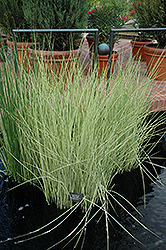>> Home
Height: 4 feet
Spread: 3 feet
Sunlight:
![]()
![]()
Hardiness Zone: (annual)
Description:
A marginal pond plant that will make a dramatic frame to any water feature; tall, thin, tubular leaves emerge white, and mature to light green; white color is maintained by removing older foliage
Ornamental Features
White Rush's grassy leaves emerge white in spring, turning emerald green in colour with prominent light green stripes throughout the season on a plant with an upright spreading habit of growth.
Landscape Attributes
White Rush is a dense herbaceous annual with an upright spreading habit of growth. Its relatively fine texture sets it apart from other garden plants with less refined foliage.
This plant will require occasional maintenance and upkeep, and can be pruned at anytime. Deer don't particularly care for this plant and will usually leave it alone in favor of tastier treats. It has no significant negative characteristics.
White Rush is recommended for the following landscape applications;
- Mass Planting
- Border Edging
- Water Gardens
- Bog Gardens
Planting & Growing
White Rush will grow to be about 4 feet tall at maturity, with a spread of 3 feet. Its foliage tends to remain dense right to the ground, not requiring facer plants in front. Although it's not a true annual, this fast-growing plant can be expected to behave as an annual in our climate if left outdoors over the winter, usually needing replacement the following year. As such, gardeners should take into consideration that it will perform differently than it would in its native habitat.
This plant does best in full sun to partial shade. It prefers to grow in moist to wet soil, and will even tolerate some standing water. It is not particular as to soil pH, but grows best in rich soils. It is somewhat tolerant of urban pollution. This species is native to parts of North America. It can be propagated by division.

